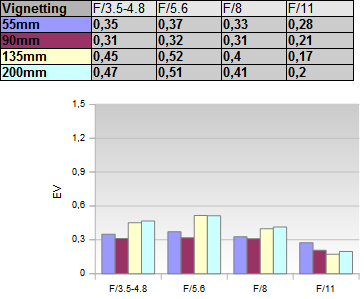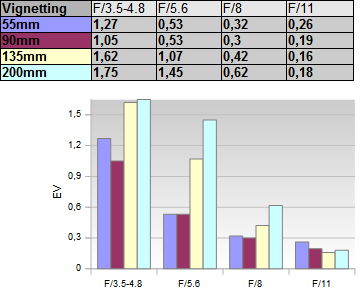|
Fujinon XF 55-200mm f/3.5-4.8 R LM OIS - Review / Lens Test Report - Analysis |
|
Lens Reviews -
Fujifilm X
|
|
Page 2 of 2

Distortion
Fujifilm relies on image auto-correction so users don't really need to worry about image distortions. Here at OpticalLimits we like to have a look behind the scenes though thus at the uncorrected data. The Fujinon shows medium pincushion distortions from 90mm onward. While this isn't overly impressive, it isn't too bad either. The 55mm doesn't show any relevant distortions even in RAW mode.
If you move your mouse cursor over the image you can switch to the corresponding auto-corrected results (there may be a short delay).
Vignetting
Vignetting is another aspect that is usually auto-corrected. While you can still spot a few remaining traces, this isn't anything to worry about using conventional image processing.
 In RAW mode - thus with disabled distortion and without vignetting compensation - it is a different story. At max. aperture there's a strong light falloff across all focal lengths. Stopping down resolves this, of course. Due to the slower speed at the long end of the range, the issue is somewhat more apparent here making it advisable to stop down to f/8 (unless corrected).
In RAW mode - thus with disabled distortion and without vignetting compensation - it is a different story. At max. aperture there's a strong light falloff across all focal lengths. Stopping down resolves this, of course. Due to the slower speed at the long end of the range, the issue is somewhat more apparent here making it advisable to stop down to f/8 (unless corrected).
 Please note that vignetting compensation is also a lossy procedure because it increases the corner (sensor-)noise.
Please note that vignetting compensation is also a lossy procedure because it increases the corner (sensor-)noise.
MTF (resolution)
The Fujinon XR 55-200mm f/3.5-4.8 R LM OIS delivered very solid resolution figures in the MTF lab. The center quality is generally very good at max. aperture and reaches the excellent mark around f/5.6. The borders and corners are very good throughout the tested aperture range. Diffraction is slightly visible at f/11 but the setting remains easily usable. Field curvature is next to non-existent.
As far as the centering quality is concerned, it was as bad as it gets with the first sample that we purchased. The lens also suffered from a mechanical breakdown. Fortunately Fujifilm replaced it and this 2nd sample had a far better centering than average for a image stabilized lens.
Please note that the MTF results are not directly comparable across the different systems!
Below is a simplified summary of the formal findings. The chart shows line widths per picture height (LW/PH) which can be taken as a measure for sharpness.
If you want to know more about the MTF50 figures you may check out the corresponding Imatest Explanations
Chromatic Aberrations (CAs)
Lateral CA (color shadows at the image borders) are very well controlled with an average pixel width of max. 0.8px - usually even much less than that.

Bokeh
An important aspect of a tele lens is the quality of the bokeh (rendering of the out-of-focus blur). Unfortunately this is not really a strong aspect of the Fujinon - at fate that it shares with many tele zoom lenses actually. Prime lenses cannot be touched here (exceptions apply, of course). The general out-of-focus blur is very smooth in front of the focus point but the more critical background is somewhat nervous.
 Out-of-focus highlights show an onion-like rendition and an outlining effect. This can be somewhat disturbing at times. The aperture shape remains circular till about f/8. It is also worth to mention that the shape deteriorates towards "cat's eyes" in the image corners.
Out-of-focus highlights show an onion-like rendition and an outlining effect. This can be somewhat disturbing at times. The aperture shape remains circular till about f/8. It is also worth to mention that the shape deteriorates towards "cat's eyes" in the image corners.

VerdictThe Fujinon XF 55-200mm f/3.5-4.8 R LM OIS is a very harmonious offering. It may not excel in quality but it has only few weaknesses. The Fujinon is pretty sharp across the zoom range and entire image field - even at max. aperture. The low amount of lateral CAs also contribute to the subjective quality perception. Due to the system's image auto-correction, neither distortion nor vignetting are relevant to the average user. Under the (RAW-)hood these two characteristics are not as quite as perfect though. The quality of the bokeh is just average for a lens in this class.
The build quality is on a very high level thanks to high quality materials and tight assembly. However, Fujifilm has overdone it with the stiffness of the zoom ring which feels inconvenient even though this may avoid zoom creeping. In terms of AF speed, the results are solid for a mirrorless system albeit not outstanding when compared to the benchmark systems. The optical image stabilizer is certainly a plus regarding the moderate max. aperture of the lens. Given the comparatively moderate pricing, the Fujinon is a obvious choice even though there isn't much to choose from in this lens class anyway. Well done, Fuji!
Mechanical Quality:
★★★★★
Click here for an explanation of our star ratings
|